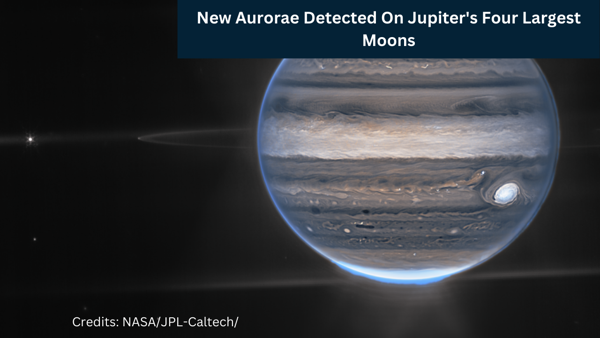
Science & Space
In Jupiter's Shadow, New Aurora Detected On Jupiter's Four Largest Inner Moons
A team of astronomers led by Caltech and Boston University discovered aurore at visible wavelengths on all four moons of Jupiter: IO, Europa, Ganymed, and Callisto using the W. M. Keck Observatory's High-Resolution Echelle Spectrometer on Maunnakea in Hawai'i.
Along with Keck Observatory’s High-Resolution Echelle Spectrometer (HIRES), a grating cross-dispersed, echelle spectrograph, they also used high-resolution spectrographs at the Large Binocular Telescope and Apache Point Observatory to make the observations.
Because of Jupiter's shadow, the observation was difficult. The aurora emitted very faint light, which the scientist detected with a pinpoint telescope gaze.
The oxygen aurora seen in skies near the Earth's poles can be seen on all four Galilean moons, but the gases on Jupiter's moons are much thinner, allowing a deep red color to glow nearly 15 times brighter than the familiar green light. That is one of the reasons that enables scientists to detect the aurora in all four moons of Jupiter.
At Europa and Ganymede, oxygen also illuminates infrared wavelengths, just a little redder than the human eye can see, the phenomenon was first observed in the Earth's atmosphere.
For IO, it's a different story. IO is the most volcanically active moon in the solar system, which is why it emits a massive cloud of gases that reaches thousands of miles into the sky. These gas clouds contain salts like sodium chloride and potassium chloride, which break down to produce additional colors when broken down. The yellow glow is caused by the presence of sodium, just as we saw in our cities during periods of heavy pollution and in the sodium vapor lamps. One exceptional aurora that has been detected is potassium aurora, which has never been seen before anywhere in the solar system.
The new measurements reveal little evidence for water, fueling an ongoing scientific debate about whether the atmospheres of Jupiter's moons contain significant amounts of water vapor. The outer three Galilean moons of Jupiter are thought to have oceans of liquid water beneath their thick icy surfaces, and there is some evidence that water in Europa's atmosphere may occasionally be sourced from its ocean or liquid reservoirs within its ice shell.
The intensity of the aurora in Jupiter's moon changes with the position of the moons around the mother planet because Jupiter has a very strong magnetic field that has been bombarding Jupiter's moon since the formation of the solar system, and this is one of the main factors that cause the aurora to change.
The discovery of a new type of aurora in Jupiter's four moons will pique the interest of young scientists in this field. Now, in this golden age, newcomers will dissect every cosmological discovery with the help of new extraordinary space telescopes and space probes such as NASA's Juno and James Webb.

0 Comments